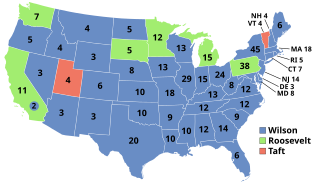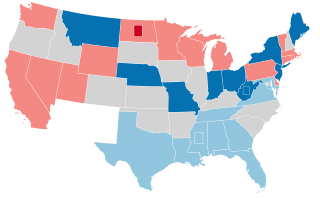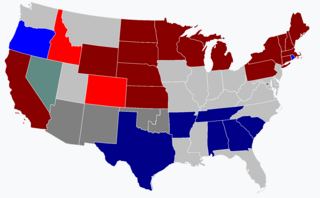Related Research Articles
The 1818–19 United States House of Representatives elections were held on various dates in various states between April 26, 1818 and August 12, 1819. Each state set its own date for its elections to the House of Representatives before the first session of the 16th United States Congress convened on December 6, 1819. They occurred during President James Monroe's first term. Also, newly admitted Alabama elected its first representatives in September 1819, increasing the size of the House to 186 seats.

The 1912 United States elections elected the members of the 63rd United States Congress, occurring during the Fourth Party System. Amidst a division between incumbent Republican President William Howard Taft and former Republican President Theodore Roosevelt, the Democratic Party won the presidency and both chambers of Congress, the first time they accomplished that feat since the 1892 elections.

The 1908 United States elections elected the members of the 61st United States Congress, occurring during the Fourth Party System. Oklahoma joined the union during the 61st Congress. Despite the Panic of 1907, Republicans continued to control the presidency and both houses of Congress.

The 1904 United States elections elected the members of the 59th United States Congress. It occurred during the Fourth Party System. Republicans maintained control of the presidency and both houses of Congress. For the first time since the 1828 election, no third party or independent won a seat in Congress.

The 1910 United States elections elected the members of the 62nd United States Congress, occurring during the Fourth Party System. The election was held in the middle of Republican President William Howard Taft's term. The Socialist Party won election to Congress for the first time. Arizona and New Mexico were admitted as states during the 62nd Congress.

The 1902 United States elections elected the 58th United States Congress, and occurred in the middle of Republican President Theodore Roosevelt's first term, during the Fourth Party System. Roosevelt had become president on September 14, 1901, upon the assassination of his predecessor, William McKinley. Republicans retained a majority in both chambers of Congress, while the Populist Party and Silver Republican Party disappeared from Congress.

The 1888 United States elections occurred during the Third Party System, and elected the members of the 51st United States Congress. North Dakota, South Dakota, Montana, Washington, Idaho, and Wyoming were admitted during the 51st Congress. This election was the first time that one party had won a majority in both chambers of Congress since the 1874 elections.

The 1840 United States elections elected the members of the 27th United States Congress, taking place during the Second Party System. In the aftermath of the Panic of 1837, the Whigs become the fourth party in history to win control of the presidency and both houses of Congress; the Whigs would never again accomplish this feat. The election also marked the first time since the 1834 elections that the Democratic Party did not control the presidency and both chambers of Congress.

The 1820 United States elections elected the members of the 17th United States Congress. The election took place during Era of Good Feelings and the First Party System. Despite the Panic of 1819, the Democratic-Republican Party maintained control of the presidency and both houses of Congress, while the Federalist Party provided only limited opposition. Missouri joined the union during the 17th Congress.

The 1816 United States elections elected the members of the 15th United States Congress. Mississippi and Illinois were admitted as states during the 15th Congress. The election took place during the First Party System. The Democratic-Republican Party controlled the presidency and both houses of Congress, while the Federalist Party provided only limited opposition. The election marked the start of the Era of Good Feelings, as the Federalist Party became nearly irrelevant in national politics after the War of 1812 and the Hartford Convention.

The 1812 United States elections elected the members of the 13th United States Congress. The election took place during the First Party System, and shortly after the start of the War of 1812. The Federalist Party made a relatively strong showing, winning seats in both chambers while supporting a competitive challenge to the incumbent Democratic-Republican president. However, the Democratic-Republican Party continued its control of the presidency and both houses of Congress.

The 1808 United States elections elected the members of the 11th United States Congress. The election took place during the First Party System. In the aftermath of the Embargo of 1807, the Federalists picked up congressional seats for the first time since their defeat in the 1800 election. However, the Democratic-Republican Party maintained control of the presidency and both houses of Congress.

The 1804 United States elections elected the members of the 9th United States Congress. The election took place during the First Party System. The Democratic-Republican Party continued its control of the presidency and both houses of Congress.

The 1800 United States elections elected the members of the 7th United States Congress. The election took place during the First Party System, and is generally considered the first realigning election in American history. It was the first peaceful transfer of power between parties in American history. The Democratic-Republican Party won control of the presidency and both houses of Congress for the first time. Conversely, the Federalist Party would never again control the presidency or either house of Congress. Ohio was admitted as a state during the 7th Congress.
The 1802 United States elections occurred in the middle of Democratic-Republican President Thomas Jefferson's first term, during the First Party System. Members of the 8th United States Congress were chosen in this election. Democratic-Republicans picked up several seats in both chambers of Congress, solidifying their control over the House and Senate.
The 1806 United States elections occurred in the middle of Democratic-Republican President Thomas Jefferson's second term, during the First Party System. Members of the 10th United States Congress were chosen in this election. Neither chamber saw significant partisan change, with the Democratic-Republicans retaining a commanding majority in both the House and Senate.
The 1810 United States elections occurred in the middle of Democratic-Republican President James Madison's first term, during the First Party System. Members of the 12th United States Congress were chosen in this election. During the 12th Congress, Louisiana joined the union. Democratic-Republicans continued to control both chambers of Congress.
The 1814 United States elections occurred in the middle of Democratic-Republican President James Madison's second term, during the First Party System. Members of the 14th United States Congress were chosen in this election. During the 14th Congress, Indiana joined the union. The election took place during the War of 1812.
The 1822 United States elections occurred in the middle of Democratic-Republican President James Monroe's second term, and was the last election of the First Party System. Members of the 18th United States Congress were chosen in this election. The 1820 census added 26 seats to the House. Democratic-Republicans continued to dominate both chambers of Congress.

The 1866 United States elections occurred in the middle of National Union/Democratic President Andrew Johnson's term, during the Third Party System and Reconstruction. Johnson had become president on April 15, 1865, upon the death of his predecessor, Abraham Lincoln. Members of the 40th United States Congress were chosen in this election. As this was the first election after the Civil War, many ex-Confederates were barred from voting, and several Southern states did not take part in the election. Delegations from Arkansas, Florida, Alabama, North Carolina, Louisiana, and South Carolina were re-admitted during the 40th Congress.
References
- ↑ Not counting special elections.
- 1 2 Congressional seat gain figures only reflect the results of the regularly-scheduled elections, and do not take special elections into account.
- ↑ "Party Divisions of the House of Representatives". United States House of Representatives. Retrieved 25 June 2014.
- ↑ "Party Division in the Senate, 1789-Present". United States Senate. Retrieved 25 June 2014.